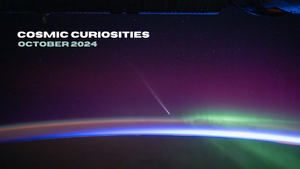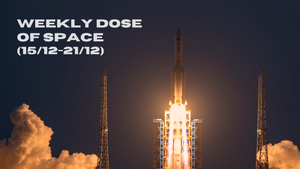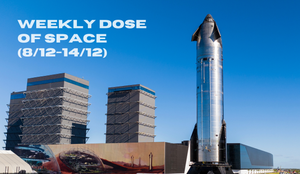
Oct 1, 2024
Cosmic Curiosities - October 2024
Hello and welcome to the third installment of the "Cosmic Curiosities" newsletter! In this monthly newsletter, we will go over the big astronomy events you should expect in the coming month. From meteor showers to planetary aligning's and anything in between. We also will dive into all of the out-of-this-world discoveries and big stories from the past month!
What's up this month?
Perfect time to view Andromeda - October 1st

Kicking off the first of the month, Andromeda, our closest galactic neighbor at 2.5 million light-years, will be very visible in our night sky. The galaxy will rise to its highest point in the sky around midnight on the 1st. With each subsequent day, the point at which Andromeda is the highest in our night sky will be reached four minutes earlier. To spot Andromeda, look to the East near the constellations Cassiopeia or the "great square."
While Andromeda can be seen with the naked eye if the conditions are right, a small telescope or binoculars are recommended!
New Moon at Apogee and a Solar Eclipse - October 2nd

On the second of October, the Moon will restart its lunar cycle, meaning the sky's are at their darkest. The Moon will also be at its orbital apogee (furthest point in an orbit), meaning the Moon will appear a little smaller than usual as it is the farthest away from Earth. A solar eclipse will also occur, and it will be visible from the Southern hemisphere, particularly parts of South America, like Chile and Argentina. If you are lucky enough to live within the narrow corridor of the eclipse's path, you should be able to see a ring of fire!

If the weather permits, this will be an excellent time to head outside and look at the stars. And if you live in South America, be sure to head outside and try to catch a glimpse of the solar eclipse!
Comet to make historic flyby of Earth - October 8th/9th

In January 2023, the Purple Mountain Observatory (Tsuchinshan) in China discovered what appeared to be an asteroid. However, in February, as more data poured in, the object's classification changed to a Comet. With the new information gathered on this interplanetary voyager, scientists could calculate the object's orbit and the last time it came close to our planet. The Comet last flew by Earth some 80,000 years ago, which makes this a genuinely historic flyby.
You may have already seen the images from Don Pettit or Matthew Dominick aboard the ISS, among others, who have captured the Comet rising above the horizon in the Early morning hours. However, ATLAS is believed to appear even brighter in the second week of October. On the 8th and 9th of October, the Comet could appear as bright as Venus, which will be the best time to view it. However, the Comet should remain visible, but far dimmer, up until the 26th of October, if not longer.
To try and capture a glimpse of the Comet, look low and to the west/southwest after sunset. As time passes, the Comet will rise into the night sky but slowly dim. It is visible to the unaided eye, but using a telescope or binoculars will give you the best view!
Hunters Moon - October 17th

In the last edition of this newsletter, September featured a "harvester" Moon, which farmers gave the name due to its usefulness in helping with crop harvesting at the latter parts of the night. In a time before electricity, or at least the widespread use of electricity, the Moon and its cycles were crucial to various industries. The same applies to hunters, hence the name "Hunters" Moon. The name was coined due to the reliance on Moonlight for hunting late at night, especially to stock up on food for the coming winter. The Moon will also be a supermoon, which means it's at its closest to Earth!
Two Meteor Showers

Draconid - October 7th
This is the first of the two meteor showers set to take place in October. The shower will begin on the 6th, peak on the 7th, and last until the 12th. With a peak of 10 shooting stars an hour, this is the more minor meteor shower of the month.
The meteor shower will originate from the constellation Draco, so for your best chance to spot this dazzling light show, look towards the North after sunset! The biggest plague to stargazing is either light pollution or weather. So, if you miss the Draconid meteor shower, don't fret, as the show is only about to begin!
Orionid - October 21st
The Orionid meteor shower began in late September and will end in late November. Despite its long duration, the Orionid peaks in October, on the 21st, to be exact. At its peak, it will see double the number of shooting stars compared to Draconid.
For the best viewing possible, look toward the southwestern sky after sunset, towards the constellation Orion. Happy star-watching!
Interstellar news from September
Hubble finds that black hole beams promote stellar eruptions

Hubble has spotted some weird behavior from the black hole at the center of the elliptical galaxy, M87. The supermassive black hole has ejected a 3,000-light-year jet of plasma out into the galaxy. Scientists have noticed that stars on the edge of this jet are prone to "explode" twice as much as stars elsewhere in the galaxy. These explosions are referred to as Novae, and they are surprisingly common in the universe. Every day, at least one novae erupts in M87 alone, and astronomers believe 1 million novae explode every second in the entire universe. While scientists don't know why Novae are more common near this jet of plasma, the sheer prevalence of eruptions closer to the jet, compared to data collected from the rest of the galaxy, leads astronomers to believe the plasma jet stream is causing this. A leading theory is that the path of the plasma is "snowplowing" hydrogen into stars, leading to an explosion. However, more data is needed to better understand what is going on.
If this is the case, it shows that black holes can play a significant role in keeping the stellar cycle alive despite the insane destruction they cause as these stellar eruptions will lead to the formation of new stars.
Hubble and MAVEN team up to solve a Martian mystery

NASA's Hubble Space Telescope and the Mars Atmosphere and Volatile Evolution (MAVEN) spacecraft teamed up to solve one of the big mysteries surrounding Mars. Looking at Mars now, you see this dry, desert world. It would be hard to believe that some billions of years ago, the red planet harbored oceans spanning hundreds of kilometers. There were some theories about how Mars lost its oceans, but nothing has been proven. That was until these images from Hubble allowed scientists to see hydrogen atoms escaping Mars into space. (Image rotated to fit the site better, source image here)

There are only two places water can go. It can freeze into the ground, or the water molecule can break into atoms, and the atoms can escape from the top of the atmosphere into space....to understand how much water there was and what happened to it, we need to understand how the atoms escape into space." - John Clarke of the Center for Space Physics at Boston University in Massachusetts
While Hubble did take the definitive image to prove that hydrogen atoms, broken up by sunlight, were indeed escaping into space, MAVEN played a massive role in this discovery. With MAVEN, scientists knew that hydrogen and deuterium (a hydrogen molecule with a neutron in its nucleus), which is commonly referred to as "heavy hydrogen," were being broken apart. However, being heavier than hydrogen, deuterium is escaping the red planet's atmosphere far slower. With this in mind, scientists back on Earth are using this data and creating models that can "wind the clock" on how much water was on Mars and how much water escaped for any given year, dating billions of years back.
JWST finds "missing link" to star formation

Using data from Webb, astronomers Alex Cameron and Harley Katz have made a compelling discovery that may further piece together the formation of the early Universe. They found a collection of gas heated by scorching and massive stars, stars hotter than those in our more evolved and local Universe. These stars were heating this gas so much to the point it actually outshone the stars. Typically, stars at the more prominent and hotter end reach temperatures of 40,000-50,000 Celsius. However, Cameron and his team believe that galaxy 9422 has/had stars with temperatures reaching 80,000 Celsius, which is a massive difference compared to stars today. While it makes sense that stars formed while the Universe was relatively young and would differ from stars today, this discovery may be a missing link in early star formation. The team of astronomers and scientists believe that Galaxy 9422 was in the midst of an intense star formation period fueled by a dense cloud of gas.
The team plans to look at other similarly aged galaxies to determine how common or rare this phenomenon was at the time.
My first thought in looking at the galaxy’s spectrum was, ‘that’s weird,’ which is exactly what the Webb telescope was designed to reveal: totally new phenomena in the early Universe that will help us understand how the cosmic story began.” - Alex Cameron Lead Research at the University of Oxford, UK.
China's FAST radio telescope to expand

China's Five-hundred-meter Aperture Spherical Telescope, or FAST radio, is the largest diameter single-dish radar telescope in the world. However, it is currently undergoing an expansion in the form of 24 moveable radio telescopes, each with a dish spanning 40 meters in diameter. This expansion will allow for a much greater resolution, enabling better study of deep space objects, such as fast radio bursts, gravitational waves, black hole tidal disruptions, and supernova, among other things. This expansion will also allow communication with probes, situational awareness, and the discovery of new small solar system objects.
The expansion's construction began recently, on September 25th, the 8th anniversary of FAST's completion. FAST is located in a remote part of Guizhou, southwest China. The giant radio observatory fully came online in 2020, and since then, it has discovered 900+ pulsars.
NASA continues working on Lunar time zone

As robotic and crewed missions become more prevalent in the coming decade(s), distinguishing lunar time to Earth time and vice versa is crucial. That is why NASA, still a few years away from landing humans on the Moon, is pushing forward to create a coordinated lunar time (LTC). Having a dedicated time zone, similar to coordinated universal time (UTC) here on Earth, will allow for better mission planning and management between space agencies. It will also allow for telescopes on the lunar surface to be synced, science experiments time-stamped, and complex spacecraft events, such as orbital burns or docking, to be completed without a hitch.
To create the lunar time zone, a collection of atomic clocks will be placed at various points around the Moon, giving a fairly accurate time zone. Despite the extreme accuracy of atomic clocks, I say "fairly" as the Moon being tidally locked with Earth has its issues. Gravity can mess with the speed of these instruments, which can make two different clocks a few dozen milliseconds off by the end of the day. While that sounds like a little, it adds up and can be problematic, especially for spacecraft operating at absurd speeds.
Regardless, a time zone made for the Moon is a significant first step as humanity implements plans to enable a lunar economy. The White House has given NASA until Dec 31st, 2026, to plan the creation and implementation of LTC.
The existence of a common time reference is the basis of our everyday life activities on Earth, and the same will be true on the Moon with the development of a lunar economy and the expansion of lunar exploration." - Javier Ventura-Traveset, Moonlight Project navigation manager at the European Space Agency (ESA)
Hubble spots a plethora of ancient black holes

NASA's Hubble space telescope, a legendary piece of science equipment that has been operating for decades, is still making discoveries today. Recently, the orbital observatory has spotted a large number of ancient black holes, shocking astronomers. These black holes were formed not long after the Big Bang (relatively), and while this alone isn't shocking, the shocking part is just how massive and common they are.
Many of these objects seem to be more massive than we originally thought they could be at such early times — either they formed very massive or they grew extremely quickly." - Alice Young, a PhD student from Stockholm University
There are a few potential explanations for how the black holes formed, such as the collapse of supermassive pristine stars, collapsing gas/dust clouds, the merging of star clusters, and potentially primordial black holes that formed just after the Big Bang. However, this is the least supported explanation. Astronomers will be keen to collect more data, which will be needed to fully validate any theories.
To aid in these newly discovered black holes, The James Webb Space Telescope also looks back to early black holes to help astronomers better understand the formation of galaxies and the early universe.
Celestial spotlight
To cap off another Cosmic Curiosities, lets go over the space image of the month!

Matthew was the runner-up last time, but this month, he redeemed himself with this magnificent photo taken during his stay aboard the ISS! As mentioned earlier, we have pictured the Comet Tsuchinshan-ATLAS rising above the planet just before orbital sunrise. I genuinely feel like I don't have to explain the reasoning as to why I picked this image as the image of the month; I mean, look at it. It is genuinely breathtaking. The green aurora, purple sky, a hint of the Sun, and a passing by interplanetary voyager are just perfect. If I had a limited number of photos, I could show someone why space exploration matters and why it is so captivating; this would be one of them. Matthew is such a talented photographer. I highly recommend checking out his Twitter, as he has a lot of incredible work.
Here is a time-lapse Matthew also took:
Comet rises above the horizon just before orbital sunrise amongst aurora and swirling satellites.
— Matthew Dominick (@dominickmatthew) September 29, 2024
Timelapse composed from 1/4s, 50mm, f1.2, ISP 6400 images played at 30fps. pic.twitter.com/mdb8KpzlAo
This is one of the rarer images, and the fact that the ISS has two skilled astrophotographers onboard has been a blessing to all of us back on the ground.
That is all from us this month, see you back at the start of November!



